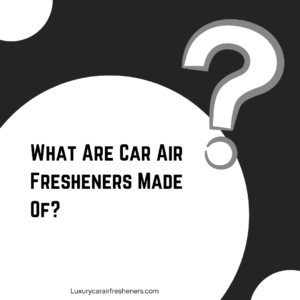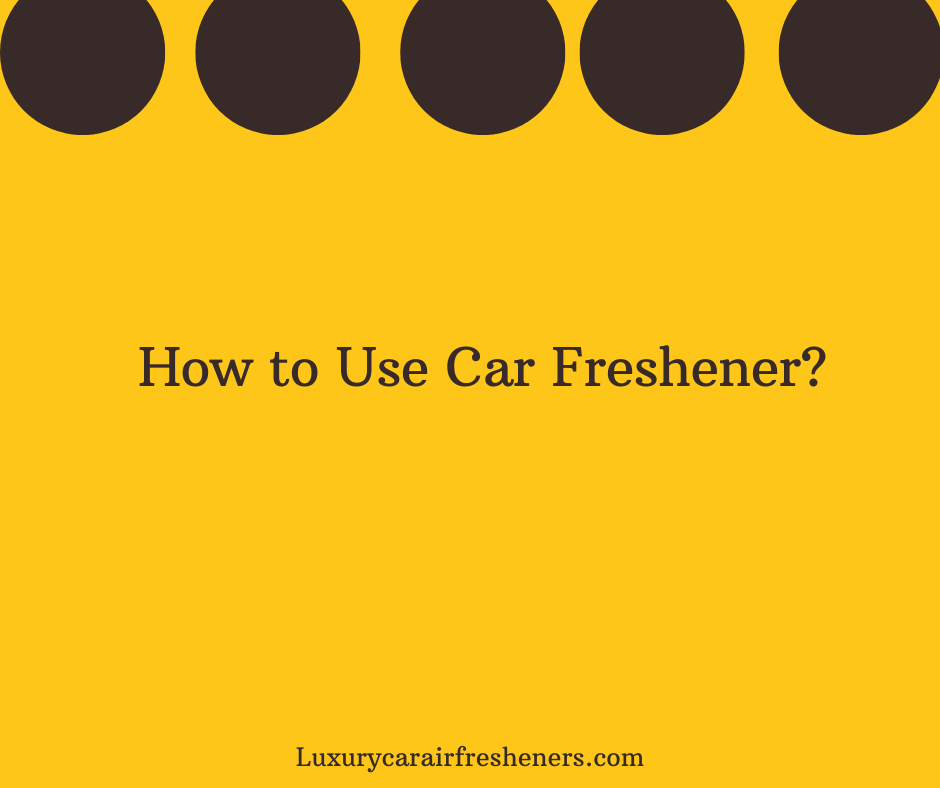What Are Car Air Fresheners Made Of? A Deep Dive into the Ingredients
That familiar scent of “New Car,” “Black Ice,” or “Linen Fresh” that fills your vehicle is a small but significant part of the daily driving experience for millions of Americans. Car air fresheners are a multi-billion dollar industry, offering a simple solution to combat everything from stale air to lingering fast-food odors. But have you ever stopped to wonder what’s actually *in* that little cardboard tree or scented vent clip? What magical concoction are you breathing in during your daily commute? 🚗
The answer is a fascinating blend of chemistry and design. A car air freshener is more than just a splash of perfume on paper; it’s a carefully engineered delivery system designed for slow, consistent release. The ingredients can range from complex synthetic compounds created in a lab to simple, natural essential oils. Understanding this composition is key for any consumer looking to make an informed choice about the products they use in their personal space.
This comprehensive guide will pull back the curtain on the car air freshener industry. We’ll explore the core components that make up these products, from the base materials to the fragrance chemicals, and discuss the growing trend of natural and DIY alternatives. Whether you’re a scent connoisseur or simply a curious consumer, this deep dive will change the way you think about that little scented accessory hanging from your rearview mirror.
Key Takeaways: The Scent Breakdown 🔬
- Car air fresheners are composed of two main parts: a **base material** (the carrier) and a **fragrance mixture** (the scent).
- The fragrance mixture is a blend of **solvents** and **fragrance compounds**. Solvents control the scent’s evaporation rate.
- Fragrance compounds can be **synthetic** (like aldehydes and esters) or **natural** (like essential oils). Most commercial products use a blend of both.
- The type of base material—paper, gel, polymer, ceramic—determines the freshener’s form factor and how it releases the scent.
- Growing consumer interest in transparency and health is driving a trend towards natural alternatives like car diffusers that use pure essential oils.
The Anatomy of a Car Air Freshener: Two Core Components
Regardless of whether it’s a hanging tree, a vent clip, or a can of gel, every car air freshener is built on the same two-part principle: a carrier medium and a scented liquid that it holds and releases.
1. The Base Material (The Carrier)
The base is the physical structure of the air freshener. Its primary job is to absorb a significant amount of fragrance oil and then release it slowly and consistently over a period of weeks. The material choice dictates the freshener’s form and function.
- Porous Paper/Cardboard: This is the classic material used for the iconic hanging car fresheners. It’s inexpensive and highly absorbent. The paper is die-cut into a shape and then saturated with the fragrance mixture.
- Gels and Beads: These are typically made from a water-based polymer (like polyacrylamide) that can absorb and hold a large amount of fragrance. As the water evaporates, it carries the fragrance into the air. This is common in under-the-seat cans.
- Porous Polymers/Plastics: Modern vent clips and other solid fresheners are often made from a special type of microporous plastic. This material is infused with fragrance during the manufacturing process, allowing for a very long-lasting and controlled release.
- Ceramics and Wood: These are common in higher-end or eco-friendly products. Porous ceramic discs or wooden blocks can be infused with fragrance and are often reusable, allowing you to “recharge” them with your own essential oils.
2. The Fragrance Mixture (The Scent)
This is the liquid that gives the air freshener its smell. It’s not just a simple perfume; it’s a carefully balanced chemical formula designed for optimal performance. It contains two main types of ingredients.
A. Solvents and Carrier Agents
These are colorless, odorless liquids that act as the base for the fragrance. Their job is to dissolve the various scent compounds and, most importantly, to control the rate of evaporation. Without a solvent, the fragrance would be overpowering for a day and then disappear. Common solvents include:
- Dipropylene Glycol (DPG): One of the most common carrier oils in the fragrance industry. It’s excellent at binding with fragrance molecules and has a very slow evaporation rate, making it ideal for long-lasting products.
- Mineral Oil or Other Glycol Ethers: These serve a similar function to DPG, providing a stable base for the fragrance.
Think of the solvent as the “time-release” mechanism. It’s the unsung hero that ensures your air freshener lasts for weeks instead of hours.
B. Fragrance Compounds
This is the complex blend of chemicals that actually creates the scent we smell. In most commercial air fresheners, this is a proprietary “secret recipe” containing dozens or even hundreds of individual ingredients, which can be either synthetic or natural.
- Synthetic Fragrances: The vast majority of scents are created in a lab. Chemists use a palette of aromatic molecules to construct specific smells. Common classes of these chemicals include **esters** (often fruity, like the banana scent isoamyl acetate), **aldehydes** (often fresh or citrusy, like the lemon scent citral), and **ketones** (can be floral or musky). These are highly stable, consistent, and cost-effective.
- Natural Essential Oils: These are aromatic compounds extracted directly from plants (e.g., lavender oil, lemon oil, peppermint oil). While popular, they can be more expensive and less stable than synthetic alternatives, which is why many products use a blend. The rise of personal car diffusers has made using pure essential oils much more common for car scenting.
| Freshener Type | Typical Base Material | Common Scent Ingredients | Primary Use Case |
|---|---|---|---|
| Hanging Cardboard | Porous paper | DPG, Synthetic Esters & Aldehydes | Inexpensive, wide variety of scents. |
| Vent Clip | Microporous Polymer | DPG, proprietary synthetic fragrance blend | Long-lasting, activated by airflow. |
| Gel Can | Water-based polymer gel | Water, gelling agent, fragrance oils | Consistent release, good for under-seat placement. |
| Essential Oil Diffuser | Ceramic, felt pad, or ultrasonic mechanism | Pure, natural essential oils (e.g., Lavender, Peppermint) | Natural alternative, customizable scents. |
Regardless of the type, knowing how to use a car freshener properly is key to getting the most out of it. And with so many options, finding the best car air fresheners often comes down to personal preference for scent and delivery method.
Explore Your Scent Options
From high-tech diffusers to simple, natural solutions, there’s a world of options for keeping your car smelling great. Here are some popular and highly-rated products available on Amazon.

Little Trees Black Ice Air Freshener
The undisputed classic. This iconic cardboard freshener is made with a paper base and a proprietary blend of synthetic fragrances for its signature masculine scent.
View on Amazon
InnoGear USB Car Essential Oil Diffuser
A great example of a modern, natural alternative. This device uses water and ultrasonic vibrations to diffuse pure essential oils, giving you complete control over the ingredients.
View on Amazon
PURGGO Car Air Eco-Purifier & Freshener
This product contains just one ingredient: natural bamboo charcoal. It doesn’t add a scent but instead absorbs and eliminates odors, representing a totally fragrance-free approach.
View on AmazonFrequently Asked Questions (FAQs)
Q1: Are the chemicals in car air fresheners safe to breathe?
A: When used as directed, commercial car air fresheners sold in the U.S. are generally considered safe by regulatory bodies. However, some individuals with sensitivities, allergies, or asthma may experience irritation from certain fragrance compounds. The main concern for many is the lack of transparency, as “fragrance” is often a protected trade secret, and companies are not required to list every chemical ingredient.
Q2: What are phthalates and are they in my car air freshener?
A: Phthalates are a class of chemicals sometimes used in fragrances to make the scent last longer. Some types of phthalates have raised health concerns, and many manufacturers have voluntarily removed them from their products in response to consumer pressure. If you are concerned, look for products specifically labeled “phthalate-free.”
Q3: Can I make my own car air freshener?
A: Yes, absolutely! DIY car fresheners are a great way to control the ingredients. A simple method is to put a few drops of your favorite essential oil on a felt shape, a wooden bead, or even a clothespin that you can clip to your vent. This is a cost-effective and natural alternative.
Q4: Why do some air fresheners lose their smell so quickly?
A: This usually comes down to the quality and concentration of the fragrance oil and the effectiveness of the solvent used. Cheaper products may use more alcohol-based solvents, which evaporate quickly. Your car’s environment also plays a huge role. In hot summer weather, the heat will cause the fragrance to evaporate much faster than in the winter.


